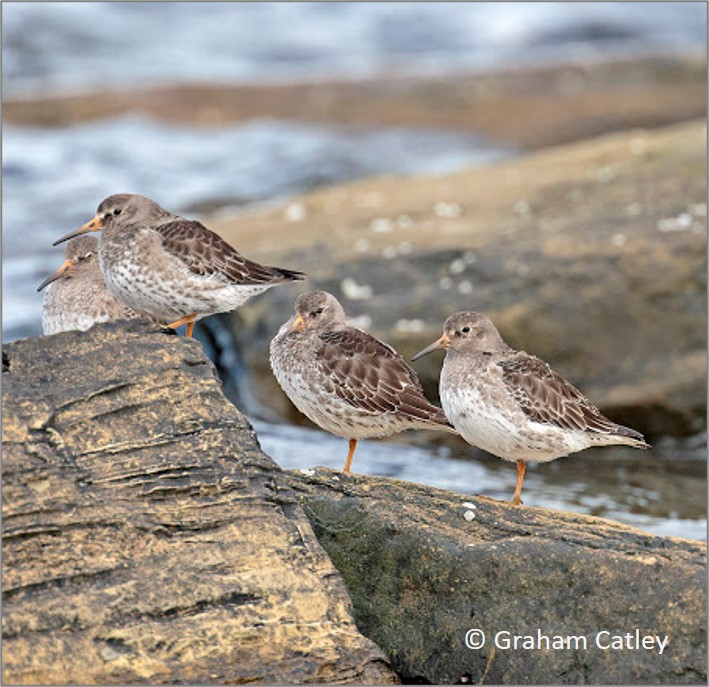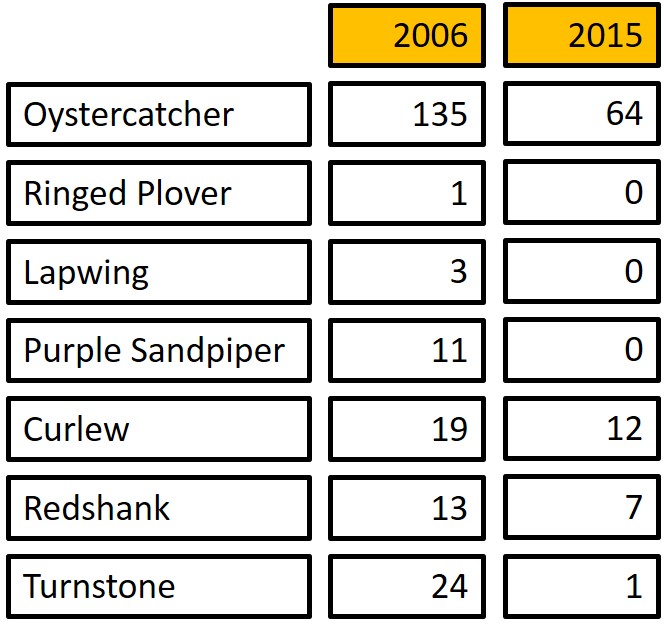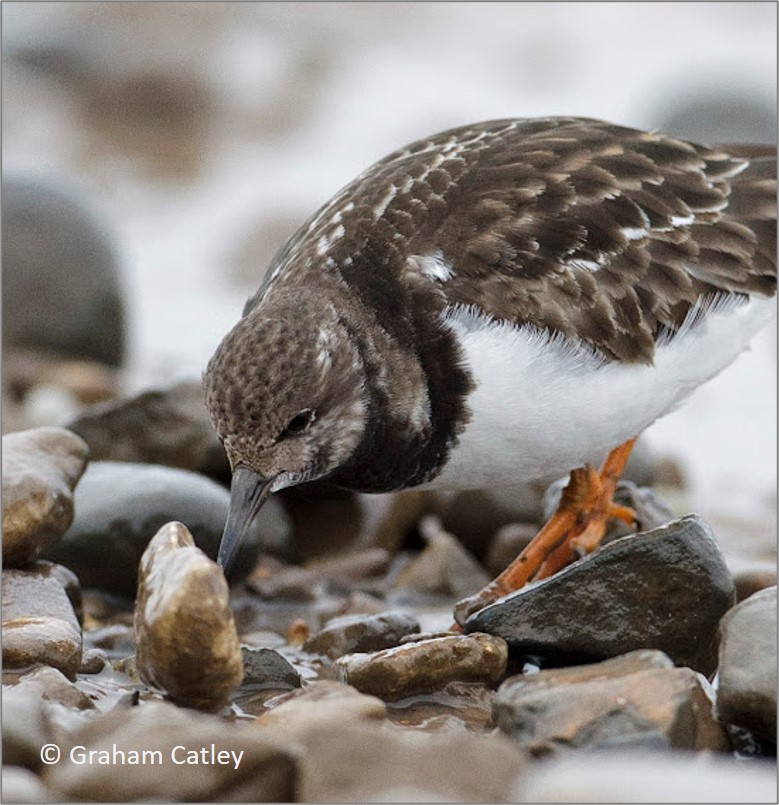The UK’s coastline is of international importance because of the numbers of waders that it supports. In winter it accommodates over a third of Europe’s wintering Oystercatcher, Ringed Plover, Bar-tailed Godwit and Knot, as well as an increasing number of Sanderling.
Wintering waders on the UK’s estuaries are counted every month but those on the 17,000 km of open coast are only counted once a decade. There are good reasons for this disparity, given the much higher development pressures on estuaries and the need for regular monitoring of sites that are designated and protected. However, this does mean that we have very little information about wintering Purple Sandpipers, the vast majority of which are not covered by monthly Wetland Bird Surveys (WeBS). Over three-quarters of the UK’s Ringed Plovers are missed too, along with over half of the Sanderling and Turnstones and nearly half of the Curlew.
The last Non-estuarine Waterbird Survey took place during the winter of 2015/16, as discussed in the WaderTales blog NEWS and Oystercatchers. Jenny Gill and I undertook counts on Great Cumbrae and along stretches of the Clyde coast, in Scotland, an area we had also covered for the 2006/07 survey. We were concerned to count only 84 waders in 2015, compared to 206 in 2006. Details are in the table alongside. We hoped that 900 other people, walking along a total of 9000 km of the UK’s coastline, had been more successful!
The paper summarising NEWS results for the whole of the UK and making comparisons with previous surveys in 1997/98 and 2006/07 was not published until 2021. In the intervening period, the counts were included in two papers about wintering populations of waterbirds in Great Britain and Ireland, that were discussed in Do population estimates matter? and Ireland’s wintering waders. This blog draws heavily on a Twitter thread from the Wetland Bird Survey and the BTO’s press release. The new paper is published in Bird Study.
The big picture
In December 2015 and January 2016, NEWS III volunteers walked along amazing, long, white beaches, surveyed rocky headlands and scrambled the lengths of boulder-strewn coves. Not every kilometre of the coast could be visited but the fact that 50% coverage was achieved meant that estimates could be made of the whole coastline of the United Kingdom, together with the Isle of Man and the Channel Isles.
In terms of absolute numbers, Scotland has consistently supported the majority of the population across all non-estuarine waterbird surveys for Oystercatcher, Ringed Plover, Golden Plover, Lapwing, Purple Sandpiper, Bar-tailed Godwit, Curlew, Redshank and Turnstone. Although this is likely to reflect the relative length of the coastline for Scotland (12,714 km) compared to England (2,705 km), Wales (1,185 km) and Northern Ireland (328 km), Purple Sandpiper, Curlew, Redshank and Turnstone still appear to show a bias towards Scotland.
Using the information collected during the survey, BTO scientists were able to extrapolate estimates of the numbers of open-coast waders in the different countries of the UK and its island dependencies (see table below). The results are published in the journal Bird Study and summarised in the table below.
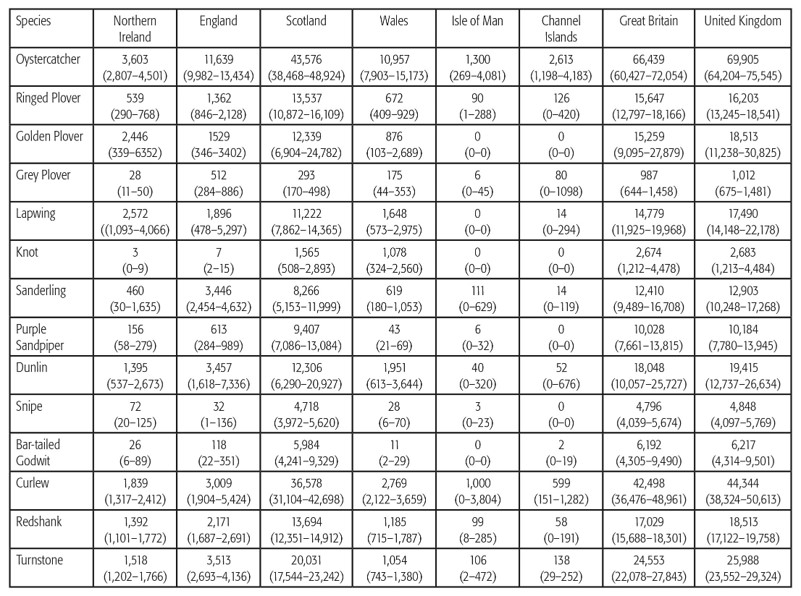
To evaluate the potential importance of the open coast, NEWS estimates for Great Britain in 2015/16 were compared to average population estimates. For eight species, the open coastline accounts for over 20% of the winter population. The figure of 113% for Purple Sandpipers suggests that more birds may have been present on the coasts of the UK in 2015/16 than in an average year or that the population estimate needs to be revisited. There are no Lapwings or Golden Plover in the table below, as there is no recent, reliable estimate of the national wintering population for either species. The Greenshank line is in italics as the sample size is small.
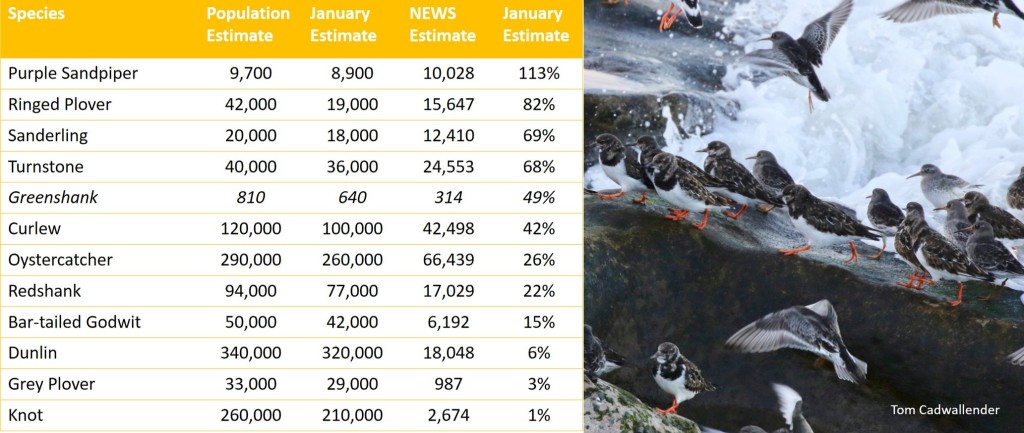
Ten species are considered in detail in the following sections. The maps were downloaded from the BTO website on 20 March 2021 (https://www.bto.org/our-science/projects/ringing/publications/online-ringing-reports). Comparisons are made between results from the Wetland Bird Survey (WeBS) and the Non-estuarine Waterbirds Survey (NEWS).
Oystercatcher
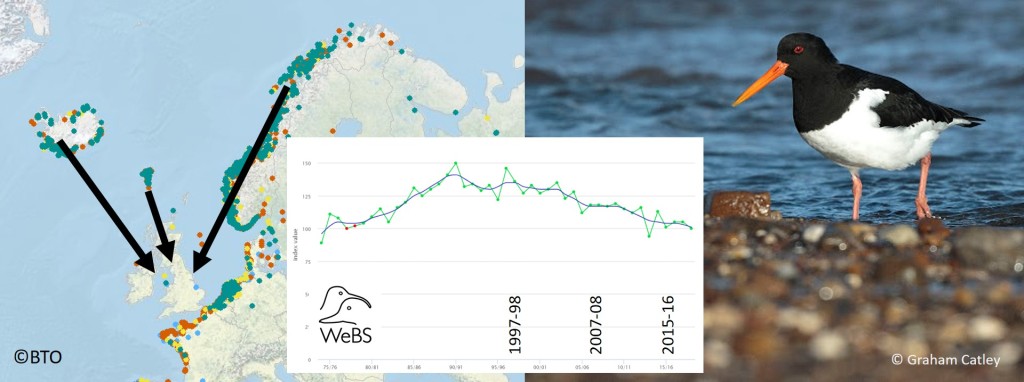
26% use open coasts. 21% NEWS decline since 1997/98. (WeBS decline 22%).
In December 2015, as we walked around the coast of Great Cumbrae in the Firth of Clyde, pairs of Oystercatchers were already staking out their territories, probably not having travelled anywhere since the previous summer or perhaps even in the last twenty years! Wintering flocks that we saw may well have included breeding birds from inland sites in Scotland, from Iceland and from Norway, together with juveniles and non-breeding sub-adults. NEWS III found that densities of coastal Oystercatchers were highest in Wales but that this is the area in which there had been the biggest declines. Breeding numbers have fallen rapidly in Scotland, as you can read in Oystercatchers: from shingle beach to roof-top.
Lapwing and Golden Plover

There was a 68% drop in Lapwing figures between 1997/98 and 2015/16 and a 59% drop in Golden Plover. NEWS and WeBS counts of Lapwing and Golden Plover are difficult to interpret because birds move readily between the coast and inland fields, in response to local conditions such as lying snow and the wetness of fields. This is further complicated in more prolonged freezing conditions, when flocks of Lapwing fly west and south in search of feeding opportunities.
Grey Plover
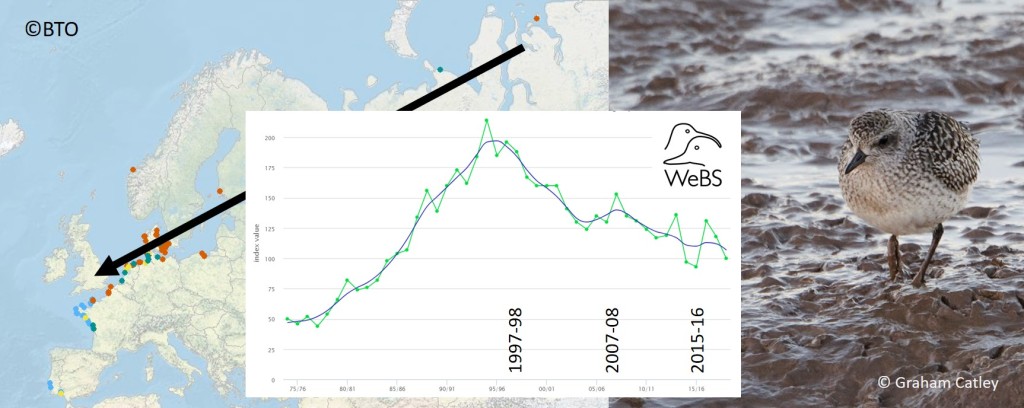
3% use open coasts. 71% NEWS decline since 1997/98. (WeBS decline 41%).
The Grey Plovers that we see around the coasts of the UK in December and January breed in Siberia. It has been suggested that one of the reasons for the decline in numbers in Britain & Ireland may be related to new generations of youngsters settling in winter locations on the continental side of the North Sea – a strategy that may now work better, given that winters are not as harsh. It is interesting that losses on open coasts, which many would consider sub-optimal habitats, have been more marked than on estuaries. There’s a WaderTales blog about Grey Plovers.
Ringed Plover

82% use open coasts. 21% NEWS decline since 1997/98. (WeBS decline 47%).
Ringed Plovers are red-listed in the UK because of the decline in winter numbers and the importance of these islands of the hiaticula race. In NEWS III, the vast majority of UK birds were found in Scotland (see earlier table) but densities were highest around the coast of England. Colour-ring studies in Norfolk showed that breeding individuals can adopt a range of migration plans – some marked birds never left the county and others had winter homes as far away as France, Scotland and Ireland. This dispersal is pretty typical of hiaticula race Ringed Plovers that nest in western Europe and southern Scandinavia. Other races travel very long distances (Well-travelled Ringed Plovers).
Curlew
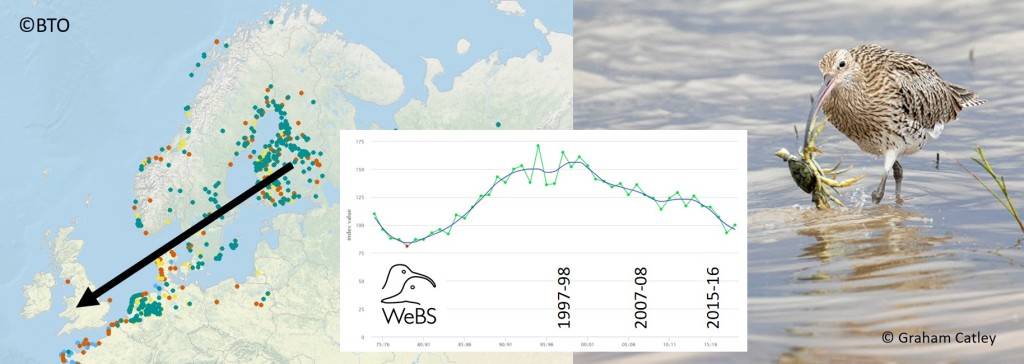
42% use open coasts. 40% NEWS decline since 1997/98. (WeBS decline 26%).
Large numbers of Curlew arrive in the UK in the autumn, with a strong link between Finland and the estuaries of England and Wales. It is estimated that 20% of Europe’s Curlew winter within the British Isles and any change in numbers has significance for a species that is already listed as near-threatened by BirdLife International. The decline in numbers on open coasts has been greater than that seen in estuaries; it has been suggested that this may relate to the breeding origins of birds using different habitats.
Bar-tailed Godwit
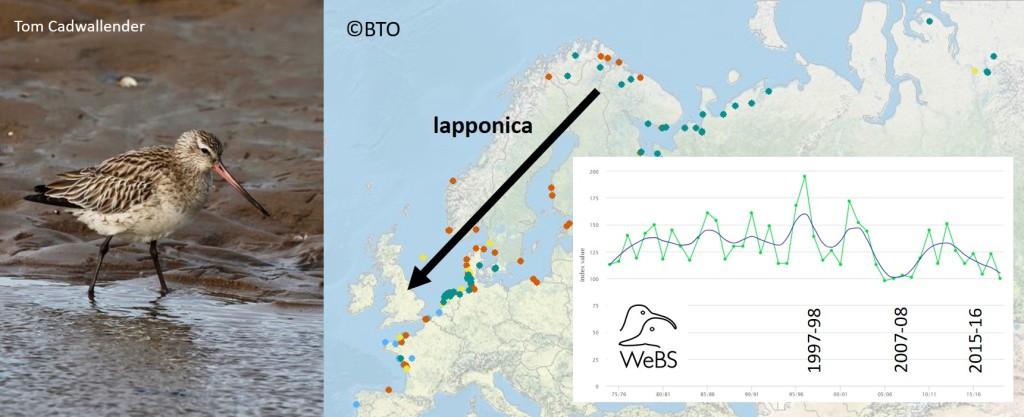
15% use open coasts. 33% NEWS decline since 1997/98. (WeBS decline 21%).
Unlike Black-tailed Godwits, which seek out the gloopiest of mud, Bar-tailed Godwits are perfectly at home on sandy shorelines. Wintering birds are of the race lapponica; these breed in Northern Scandinavia, Finland and western Russia (more here). NEWS III tells us that there has been a larger decline in numbers in coastal areas than on estuaries, perhaps related to the relative suitability of the two habitat types.
Turnstone
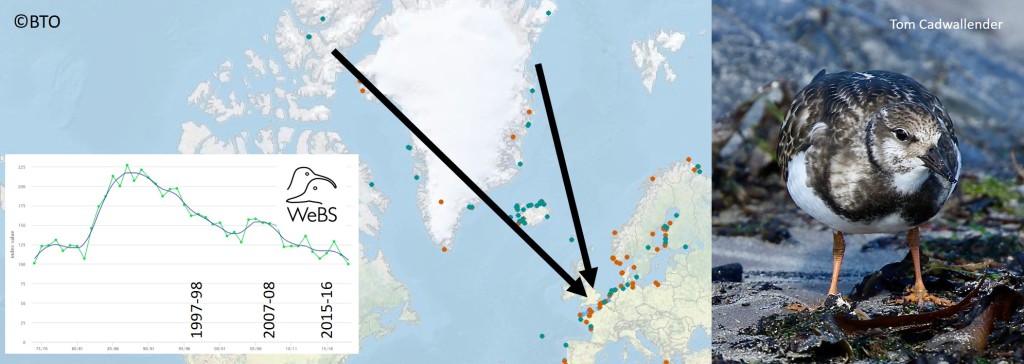
68% use open coasts. 29% NEWS decline since 1997/98. (WeBS decline 29%).
Almost all of the UK’s wintering Turnstones are thought to be birds that breed in Greenland and Canada. Declines are consistent between NEWS and WeBS. A Northumberland study has shown that, as numbers have dropped, so birds have withdrawn into areas that are less disturbed by people and dogs (See Disturbed Turnstones). About three-quarters of the UK’s open-coast Turnstones are found in Scotland but they are more thinly spread here than in England.
Sanderling
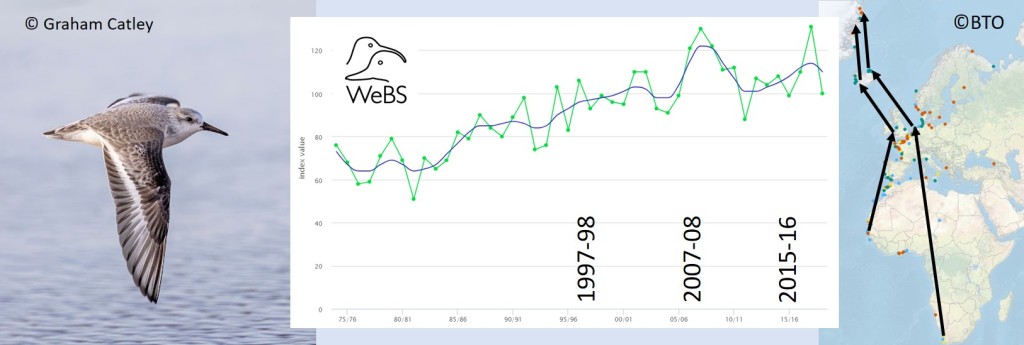
69% use open coasts. 26% NEWS increase since 1997/98. (WeBS increase 8%).
As discussed in Travel advice for Sanderling, the UK is a pretty good place to spend the winter. Whether the same would have been true for previous generations of Sanderling, that were faced with much colder winters, is open to conjecture. Since 1997/98, the densities of Sanderling in Wales have increased by 712%, by 462% in Scotland and by 85% in England. How long will it be until Sanderling flocks successfully over-winter in Iceland?
Dunlin
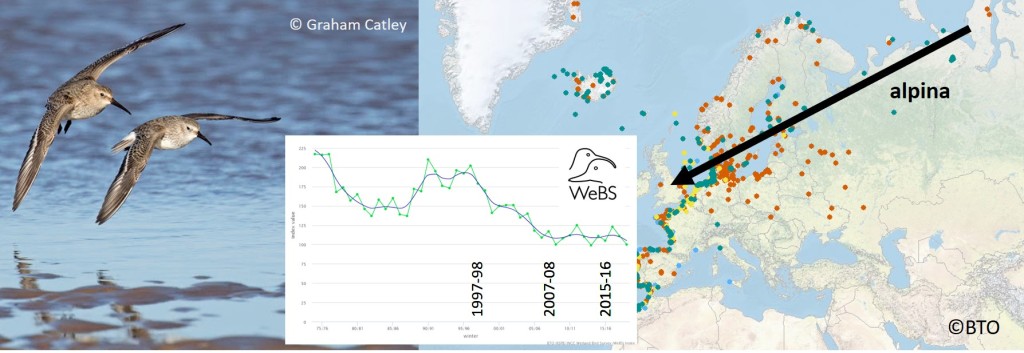
6% use open coasts. 51% NEWS decline since 1997/98. (WeBS decline 38%).
Three races of Dunlin can be seen in the UK (as you can read in Which wader, when and why?). Wintering Dunlin are birds of the alpina race, arriving in the UK from Siberia, NW Russia, northern Finland and northern Scandinavia in the late summer. Open coasts around the UK are estimated to accommodate fewer than 20,000 Dunlin. To put this into context, there are six estuaries that each hold more than this total during the winter period.
Purple Sandpiper
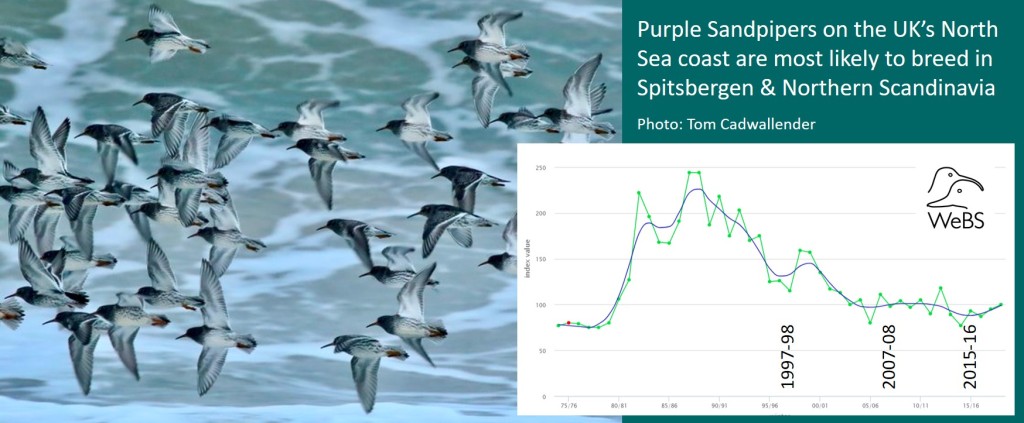
Almost all on open coasts. 19% NEWS decline since 1997/98. (WeBS decline 34%).
The rocky coasts of the UK are home to Purple Sandpipers from the Arctic, with a suggestion that North Sea coasts south of Aberdeen mainly play host to birds from Spitsbergen and northern Scandinavia, with Greenland and Canadian birds more likely to be found further north and on the Atlantic coast. Coastal numbers have declined by 19%. The Highland Ringing Group has shown that the number of young Purple Sandpipers has been declining on the Moray Firth, suggesting a period of relatively poor breeding success for birds migrating from the northwest.
Redshank
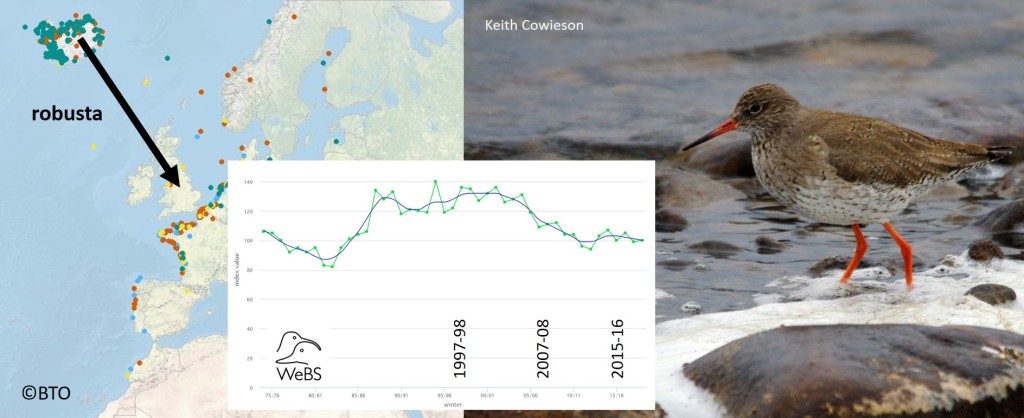
22% use open coasts. 42% NEWS decline since 1997/98. (WeBS decline 21%).
Perhaps surprisingly, few Redshank cross the North Sea to spend the winter in the UK. Winter flocks are largely made up of home-grown birds and migrants from Iceland. The recent decline in Redshank numbers is thought to be a reflection of changing numbers of British and Irish breeders, although there are no monitoring schemes to provide information about Icelandic birds. Since 1997/98, the number of Redshank on open coasts has dropped by 42% but almost all of the losses have occurred in the period since 2007/08 (37% decline between 2007/08 and 2015/16). Redshank is currently amber-listed in the UK, reflecting falling breeding numbers, but ‘promotion’ to the red list cannot be far off. There is a WaderTales blog about the rapid decline in the number of Redshank breeding on salt-marshes: Redshank – the warden of the marshes.
Summary
The Non-estuarine Waterbird Survey 2015/16 revealed that there have been major declines in abundance of four species since NEWS II in 2007/08, only eight years previously: Lapwing (down 57%), Curlew (down 31%), Redshank (down 37%) and Turnstone (down 32%). Lapwing and Curlew are both red-listed in the UK. The only species to increase is Sanderling (up by 79%).
Given the magnitude of the changes revealed in NEWS III, it is unfortunate that this labour-intensive survey can only be carried out every eight to ten years. Ideally, it might be possible to survey at least a sample of sites on an annual basis. It is certainly to be hoped that funding can be found for NEWS IV within the next few years, and that volunteers will once more be prepared to count waterbirds on beautiful, if exposed, stretches of coastline.
The results of NEWS III are published in a paper in Bird Study:
Wader populations on the United Kingdom’s open coast: results of the 2015/16 Non-Estuarine Waterbird Survey (NEWS-III) and a review of population trends. Humphreys, E.M., Austin, G.E., Frost, T.M., Mellan, H.J., Boersch-Supan, P., Burton, N.H.K. and Balmer, D.E.
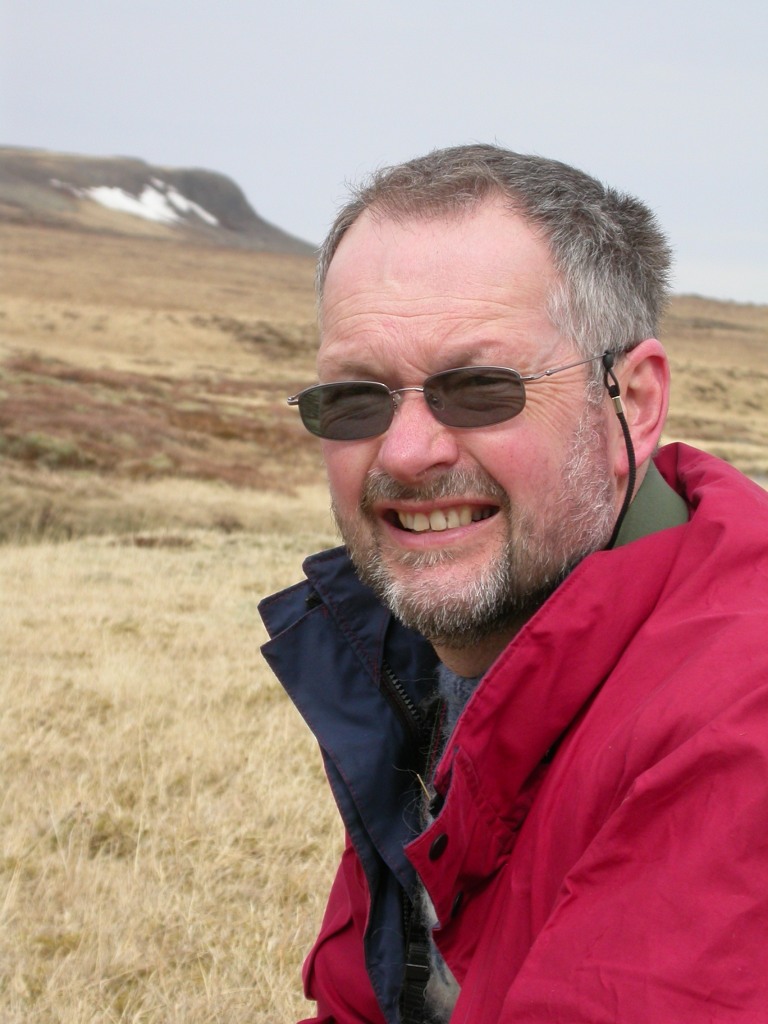
WaderTales blogs are written by Graham Appleton (@GrahamFAppleton) to celebrate waders and wader research. Many of the articles are based on published papers, with the aim of making shorebird science available to a broader audience.
